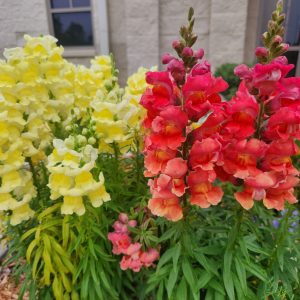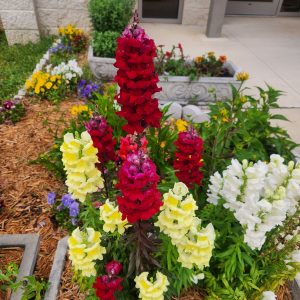Snapdragons (Antirrhinum majus) add vibrant color to fall and winter gardens in North Florida with their wide range of hues. Colors include red, orange, yellow, and maroon. Their growth varies; tall varieties reach 2–3 feet, intermediates 1–2 feet, bedding types 6–15 inches, and rock garden hybrids about 6 inches. Dark-colored flowers often have reddish stems, while pale blooms grow on light green stems. Snapdragons’ warm-colored flowers stand out in garden beds, especially when paired with white flowers, enhancing their red, orange, and maroon tones. Their fine-textured foliage contrasts nicely with large-leaved plants and compact shrubs.
Though not native to North America, they are widely cultivated and are not considered invasive. Snapdragons are versatile and ideal for mass plantings, containers, cut flowers, and edging. They are generally available within their hardiness range, making them a popular gardener choice.
Cultivars
Dwarf: ‘Floral Carpet,’ ‘Floral Showers,’ ‘Kolibri,’ ‘Royal Carpet,’ ‘Tahiti’
Intermediate: ‘Princess,’ ‘Liberty,’ ‘Sonnet,’ ‘Pixie,’ ‘Sprite,’ ‘Cinderella’
Tall: ‘Panorama,’ ‘Burpee’s Topper,’ ‘Spring Giant,’ ‘Rocket’
Care and Management
Caring for Snapdragons requires minimal work. They thrive in slightly acidic garden soil but struggle in unamended clay. Therefore, ensuring the soil remains acidic is key to their survival. They require full sun and moist soil. After the first bloom, cutting plants back to five or six nodes encourages a second flowering. Also, fertilizing at bud formation improves growth.
You can increase numbers through propagation. Propagation can be done through seeds or cuttings. Seeds germinate in 10–14 days at 70°F and should not be covered with soil. Prechilled seeds germinate best. Pinch seedlings with two to three leaf sets, except for dwarf varieties. Plant in fall for winter blooms in zones 9–11. In zone 8b and south, snapdragons may survive mild winters. Space plants 6–10 inches apart.
Pests and Diseases
Aphids: Feed on young growth, weakening plants.
Greenhouse leaf tier: Chews and webs leave; pesticides are ineffective once leaves roll.
Mites: Cause bronzed, stippled foliage, especially in hot weather.
Common Diseases
Rust: Brown pustules with yellowed leaf tissue; use proper spacing and resistant varieties.
Anthracnose: Causes sunken spots on stems and yellowing leaves; destroys infected plants.
Gray mold: Leads to wilting and stem browning; worsens in wet conditions. Remove infected stalks.
Stem rot: Cottony growth near soil line; infected plants should be removed.
Snapdragons offer rich color, versatility, and seasonal interest in gardens, making them a valuable addition for novice and experienced gardeners.
For more information contact your local extension office or click on the following links.
FPS-44/FP044: Antirrhinum majus Snapdragon
ENH1285/EP549: Planting and Propagation of Snapdragons in Florida
- Winter Bliss and Climate Challenges in North Florida Gardens - December 11, 2025
- When the Ground Moves. - September 25, 2025
- Kalanchoe Species in Florida: Invasive Threats and Management - August 15, 2025


